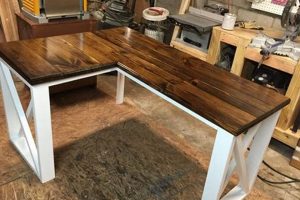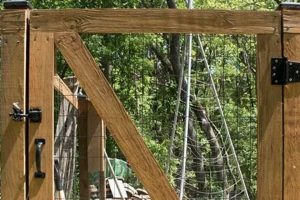The creation of a personal refuge from severe cyclonic weather events involves constructing a secure space, often below ground or heavily reinforced, designed to withstand extreme wind forces and debris impact. These constructions aim to provide immediate protection for individuals during a tornado. An example might include reinforcing an existing basement room with concrete and steel or building a dedicated underground bunker.
Such structural additions offer a critical safety measure in regions prone to tornadic activity, mitigating the risk of injury or fatality. The need for readily accessible protection has driven innovation in shelter design and construction techniques over time. This has led to a growing interest in cost-effective and accessible solutions, especially in areas where conventional storm shelters are unavailable or unaffordable.
Consequently, the following discussion will explore considerations for structural integrity, material selection, and essential design elements for effective protection. This includes information regarding permitting processes, construction methods, and vital safety precautions to ensure a secure outcome.
Essential Construction Guidance
The following points emphasize critical aspects to consider when undertaking the project. Adherence to these guidelines contributes to the structural integrity and effectiveness of the refuge.
Tip 1: Site Assessment: Prior to any excavation, a thorough geotechnical investigation is paramount. This analysis determines soil stability, groundwater levels, and potential geological hazards that could compromise the shelter’s foundation and structural integrity.
Tip 2: Structural Engineering Consultation: Engaging a qualified structural engineer is crucial for designing the shelter’s framework. The engineer can calculate load-bearing requirements, specify appropriate materials, and ensure compliance with local building codes and safety standards.
Tip 3: Reinforced Concrete Construction: Utilizing reinforced concrete walls and roofing provides optimal resistance to wind pressure and impact from flying debris. The concrete mix should be specified based on the anticipated load and environmental conditions, with appropriate reinforcement spacing and bar size.
Tip 4: Secure Entry Point: The entrance to the shelter must be designed to withstand extreme forces. A heavy-duty steel door with multiple locking points, recessed into the concrete wall, is essential for preventing breach during a tornado.
Tip 5: Ventilation System: Incorporating a passive or active ventilation system ensures a supply of fresh air during extended periods of shelter occupancy. The system should include filters to remove dust and debris and a backdraft damper to prevent outside air from entering during the storm.
Tip 6: Anchoring and Foundation: Proper anchoring of the shelter to the ground is vital to prevent uplift or displacement. The foundation should extend below the frost line and be designed to distribute the load evenly across the soil. Consider using ground anchors or helical piers for added stability, particularly in areas with unstable soil conditions.
Implementing these construction measures is vital in maximizing the refuge’s protective capabilities. Ignoring any of these points increases the risk of structural failure and compromises occupant safety.
The ensuing section will address considerations of materials and location.
1. Structural Integrity
Structural integrity forms the foundational principle for any refuge against tornadic events. The capacity of the shelter to withstand extreme wind loads, impact from flying debris, and potential ground movement is directly proportional to the integrity of its structural design and execution. Compromises in this area can lead to catastrophic failure, rendering the shelter ineffective and potentially life-threatening.
- Material Resistance to Wind Load
The selection of materials with demonstrated resistance to high wind pressures is paramount. Reinforced concrete, for example, offers a high compressive strength that resists crushing forces, while steel reinforcement provides tensile strength, preventing the concrete from cracking under stress. Improper material selection or inadequate reinforcement can result in wall or roof collapse during a tornado.
- Anchoring to Prevent Uplift
Tornadoes generate significant uplift forces that can dislodge a shelter from its foundation. Proper anchoring techniques, such as the use of ground anchors or a deep foundation extending below the frost line, are critical to counteract these forces. Insufficient anchoring can lead to the shelter being lifted and displaced, negating its protective function. A real-world example is the failure of mobile homes during tornadoes, often attributed to inadequate anchoring.
- Impact Resistance Against Debris
Airborne debris, ranging from small objects to large fragments of buildings, poses a significant threat during a tornado. The shelter’s walls and roof must be designed to withstand the impact of these projectiles. Testing standards exist to evaluate the impact resistance of building materials. The absence of sufficient impact resistance can result in penetration of the shelter, exposing occupants to danger.
- Foundation Stability and Soil Interaction
The stability of the shelter’s foundation is intrinsically linked to the surrounding soil conditions. Soil type, groundwater levels, and potential for soil liquefaction during seismic activity must be considered. A geotechnical investigation can provide critical data for designing a foundation that can withstand these challenges. Failure to account for soil conditions can result in foundation settlement, cracking, or even collapse of the shelter.
These facets of structural integrity are not independent but rather interconnected elements of a comprehensive design strategy. The goal is to create a cohesive structure capable of withstanding the complex and multifaceted forces generated by a tornado. A failure in any one of these areas can compromise the entire system, highlighting the importance of a holistic approach to shelter design and construction.
2. Material Selection
The selection of materials is a critical determinant of a refuge’s effectiveness against tornadic forces. The materials employed directly influence the structure’s capacity to withstand wind pressure, impact from debris, and potential ground movement. Therefore, careful consideration must be given to the properties and performance characteristics of each material used in construction.
- Reinforced Concrete Composition
Reinforced concrete is a prevalent material choice due to its compressive and tensile strength. The specific concrete
mix design, including the ratio of cement, aggregate, and water, directly affects its durability and resistance to cracking. The type and placement of steel reinforcement are equally important. For instance, using fiber-reinforced concrete can enhance impact resistance. A substandard concrete mix or inadequate steel reinforcement can lead to premature failure under stress, as seen in structures damaged during earthquakes due to poor construction practices. - Steel Gauge and Type
When utilizing steel components, the gauge (thickness) and type of steel (e.g., carbon steel, weathering steel) are crucial considerations. A thicker steel gauge offers greater resistance to deformation and penetration. The choice of steel type should consider corrosion resistance in the shelter’s environment. The use of insufficient steel gauge in door construction or inadequate welding techniques has resulted in breaches of seemingly secure shelters during tornado events.
- Fastener Durability and Compatibility
The fasteners used to join different materials must be durable and compatible with the materials they connect. Galvanized or stainless-steel fasteners are often preferred for their resistance to corrosion. The size, spacing, and installation method of fasteners also affect their holding power. The use of inappropriate fasteners or improper installation techniques can lead to structural weakening over time, as exemplified by deck failures due to corroded screws.
- Penetration Protection Methods
Beyond the primary structural materials, additional protective measures may be necessary to mitigate the risk of penetration by debris. The use of impact-resistant windows or shutters, and the application of protective coatings to exterior surfaces, can enhance the shelter’s overall resilience. A lack of adequate penetration protection has resulted in injuries and fatalities in shelters where occupants were exposed to flying debris entering through windows or walls.
The interplay of these material considerations determines the long-term efficacy of the refuge. Compromising on material quality or proper installation techniques can negate the benefits of even the most robust design, emphasizing the need for meticulous attention to detail throughout the construction process. Selecting the correct material will save lives and make a diy tornado shelter safe and strong.
3. Location Suitability
The selection of an appropriate location for a personal refuge from severe weather represents a primary determinant of its overall effectiveness. Location suitability entails an assessment of factors including proximity to potential hazards, geological stability, and accessibility during emergency conditions. Improper site selection can negate the protective benefits of even the most robustly constructed shelter, placing occupants at undue risk. For instance, constructing a shelter in a flood-prone area, without adequate elevation and drainage considerations, undermines its utility during heavy rainfall accompanying tornadic events. Similarly, locating a shelter beneath power lines presents a distinct hazard from falling conductors and electrical arcing during high winds.
Furthermore, geological considerations play a vital role in location assessment. Sites exhibiting unstable soil conditions, such as expansive clay or areas prone to landslides, necessitate specialized foundation design to prevent structural failure. In regions with high groundwater tables, waterproofing measures are crucial to prevent inundation of the shelter. Accessibility is a critical factor; a shelter located a significant distance from the primary dwelling may prove unusable during rapidly evolving weather events. Ideally, the shelter should be positioned to allow swift and unimpeded access from the residence, even under adverse conditions. An example of poor location planning can be seen in instances where shelters have been blocked by fallen trees or debris following a storm, rendering them inaccessible to residents.
In summary, integrating location suitability into the shelter design process is non-negotiable. A comprehensive assessment of potential hazards, geological factors, and accessibility considerations informs the selection of an optimal site. Prioritizing location suitability enhances the refuge’s functionality and maximizes its protective capabilities, thereby ensuring the safety and well-being of its occupants. Ignoring this element can lead to severe consequences, underscoring the necessity for a thorough and informed approach to site selection.
4. Ventilation System
A ventilation system is a critical, though often overlooked, component within a refuge designed for protection from tornadic events. The necessity for ventilation stems from the potential for extended occupancy within the enclosed space. Without a functional ventilation system, the accumulation of carbon dioxide and depletion of oxygen can quickly create an uninhabitable environment. Consider, for instance, a family forced to remain in a shelter for several hours following a tornado; the gradual buildup of exhaled carbon dioxide, coupled with the consumption of oxygen, presents a tangible threat of asphyxiation. Therefore, the inclusion of a properly designed ventilation system is non-negotiable for ensuring occupant safety.
Several approaches to ventilation can be implemented within a refuge, ranging from passive to active systems. Passive ventilation typically involves the incorporation of vents strategically placed to promote natural airflow, driven by pressure differentials. However, passive systems are reliant on external wind conditions, which may be unpredictable during a tornado. Active ventilation systems employ mechanical means, such as fans, to force air circulation. These systems offer greater control over airflow and can be equipped with filtration mechanisms to remove airborne debris and contaminants. The choice between passive and active systems hinges on factors such as shelter size, occupancy duration, and budgetary constraints. A shelter located in an area with persistent air quality issues, such as dust or allergens, would benefit significantly from an active system with integrated filtration.
In summary, the integration of a well-designed ventilation system is paramount for sustaining a safe and habitable environment within a refuge. While the specific type of system may vary depending on individual needs and resources, the underlying principle remains constant: to provide a continuous supply of fresh air and mitigate the risks associated with prolonged confinement. Neglecting this vital aspect can render the shelter functionally useless, highlighting the importance of incorporating ventilation considerations into the overall shelter design and construction process.
5. Entryway Security
Entryway security represents a critical vulnerability point in any personal refuge designed to withstand tornadic events. The integrity of the shelter is directly contingent upon the entryway’s ability to resist wind pressures, impact from debris, and potential forced entry. Compromises in entryway security can negate the protective measures implemented in other structural components,
rendering the refuge ineffective and potentially endangering occupants.
- Door Material and Construction
The door’s material composition and construction methods directly influence its capacity to withstand external forces. Solid-core steel doors, reinforced with internal bracing and multiple locking points, offer significantly greater resistance compared to hollow-core or wooden alternatives. Examples of door failures during tornadoes often involve the collapse or penetration of inadequately constructed entry points, highlighting the importance of robust materials and construction techniques. Choosing a door certified to withstand specific wind pressures, based on local tornado risk assessments, is a crucial consideration.
- Frame Reinforcement and Anchoring
The door frame must be securely anchored to the shelter’s walls and reinforced to prevent deformation under pressure. Welding the frame directly to steel reinforcement within the concrete walls provides superior strength compared to simply bolting it to the surface. Inadequate frame anchoring can result in the door being ripped away from the wall during a tornado, creating a breach in the shelter’s defenses. Historical examples illustrate the catastrophic consequences of neglecting frame reinforcement, leading to structural failure and occupant injury.
- Locking Mechanism Redundancy
Employing multiple locking points, utilizing a combination of deadbolts and latch bolts, enhances resistance to forced entry and pressure-induced failure. The use of high-security lock cylinders, resistant to picking and drilling, further strengthens entryway security. Relying on a single, easily compromised locking mechanism presents a significant vulnerability, as demonstrated by instances where shelter doors have been forced open during extreme weather events. Redundancy in locking mechanisms provides an additional layer of protection and ensures a higher probability of maintaining entryway integrity.
- Sealing and Weather Stripping
Effective sealing and weather stripping around the door frame prevent the intrusion of wind-driven rain, debris, and pressure surges. Compression-type seals, designed to create an airtight barrier, offer superior performance compared to conventional weather stripping. Failure to adequately seal the entryway can result in water damage, the accumulation of hazardous materials within the shelter, and an increase in internal pressure, potentially compromising structural integrity. A properly sealed entryway contributes to a more secure and habitable environment during a tornado.
These facets of entryway security are interdependent and contribute collectively to the refuge’s overall protective capability. The selection of a robust door, the reinforcement of the frame, the implementation of redundant locking mechanisms, and the installation of effective sealing measures are all essential elements. Ignoring any of these considerations compromises the shelter’s ability to withstand tornadic forces and jeopardizes the safety of its occupants. A comprehensive approach to entryway security is paramount in ensuring the effectiveness of a personal refuge from severe weather.
6. Anchoring Method
The anchoring method employed in constructing a refuge directly dictates its capacity to resist uplift forces generated by tornadic winds. The connection is one of direct cause and effect: inadequate anchoring leads to structural displacement or failure, rendering the refuge ineffective. The anchoring method is not merely an accessory; it is a foundational component, critical for maintaining the shelter’s position and integrity during a high-wind event. Real-life examples of mobile homes and poorly anchored structures being lifted and destroyed during tornadoes underscore the potentially fatal consequences of inadequate anchoring. Understanding the principles of effective anchoring is paramount for those undertaking a shelter project.
Further analysis reveals the practical considerations involved in selecting and implementing appropriate anchoring techniques. Soil type, shelter dimensions, and expected wind loads all influence the choice of anchoring method. Options range from ground anchors driven deep into the earth to concrete foundations extending below the frost line, each with its own advantages and disadvantages. The selection process should involve consultation with a structural engineer to ensure that the chosen method is suitable for the specific site conditions and structural design. Moreover, proper installation is critical; even the most robust anchoring system will fail if not correctly installed according to manufacturer specifications and engineering recommendations.
In conclusion, the anchoring method represents a non-negotiable aspect of refuge construction. Its effectiveness is directly linked to the refuge’s capacity to withstand uplift forces, thereby protecting occupants from harm. While challenges may arise in selecting and implementing the appropriate method, the practical significance of a robust anchoring system cannot be overstated. The understanding of this connection is crucial for ensuring the safety and efficacy of any personal refuge designed to provide protection during severe weather events.
7. Emergency Supplies
The inclusion of emergency supplies within a personal refuge represents a crucial component, directly impacting the safety and well-being of occupants during and after a tornadic event. A direct cause-and-effect relationship exists: the absence of adequate supplies increases the risk of injury, illness, and prolonged discomfort, even if the shelter itself remains structurally sound. Emergency supplies are not merely an afterthought; they constitute an integral element of a comprehensive shelter strategy. Instances where individuals have been trapped in shelters for extended periods without water, food, or communication devices underscore the critical importance of preparedness. A shelter capable of withstanding tornadic forces offers limited protection if its occupants lack the resources necessary for survival and recovery.
Further analysis reveals practical considerations in selecting and maintaining appropriate emergency supplies. Water, non-perishable food items, a first-aid kit, battery-powered lighting, a NOAA weather radio, and tools for communication and minor repairs form the foundation of a well-stocked shelter. The quantity and type of supplies should align with the anticipated duration of shelter occupancy and the specific needs of the occupants, including considerations for medical conditions and dietary restrictions. Regular inventory checks and replenishment of expired items are essential for ensuring the supplies remain viable. A shelter located in a remote area may necessitate a more extensive supply cache, while shelters designed for short-term occupancy may require fewer provisions.
In summary, the integration of emergency supplies into a personal refuge is paramount for ensuring the safety and resilience of its occupants. While challenges may arise in selecting, storing, and maintaining these supplies, the practical significance of preparedness cannot be overstated. The correlation between adequate supplies and improved outcomes during and after a tornado is undeniable, reinforcing the need for a proactive and comprehensive approach to refuge planning and construction. Overlooking this aspect can have severe conseq
uences, highlighting the necessity for integrating emergency preparedness into all facets of shelter design and implementation.
Frequently Asked Questions
The following addresses common inquiries regarding the construction of personal shelters from tornadic events. Clarity and precision are employed to ensure understanding of critical safety measures.
Question 1: Is constructing a personal refuge a project suitable for individuals without prior construction experience?
Construction of a structure designed to withstand extreme forces necessitates a thorough understanding of structural engineering principles and construction techniques. Engaging qualified professionals, such as structural engineers and experienced contractors, is advisable to ensure safety and code compliance.
Question 2: What are the most critical factors to consider when selecting a location for a personal refuge?
Proximity to the primary dwelling, soil stability, drainage characteristics, and potential for debris accumulation are paramount considerations. The selected location must allow for rapid access during severe weather events and provide a stable foundation for the structure.
Question 3: What materials are most suitable for constructing a refuge designed to withstand tornadic forces?
Reinforced concrete, steel, and impact-resistant materials offer the greatest resistance to wind pressure and debris impact. Material selection should adhere to established engineering standards and local building codes.
Question 4: How can adequate ventilation be ensured within a refuge designed for prolonged occupancy?
A ventilation system, either passive or active, is essential for maintaining air quality within the refuge. Passive systems rely on natural airflow, while active systems utilize mechanical means to circulate air. Filtration mechanisms may be incorporated to remove airborne debris and contaminants.
Question 5: What measures can be taken to enhance the security of the refuge entryway?
A solid-core steel door, reinforced frame, and multiple locking points enhance entryway security. The door and frame should be designed to withstand extreme wind pressures and impact from debris. Weather stripping and sealing prevent the intrusion of wind and water.
Question 6: What essential supplies should be included within a refuge to ensure occupant safety and well-being?
Emergency supplies should include water, non-perishable food items, a first-aid kit, battery-powered lighting, a NOAA weather radio, and communication devices. The quantity and type of supplies should align with the anticipated duration of shelter occupancy and the specific needs of the occupants.
Prioritizing safety and adhering to established construction standards is paramount when building refuge from severe weather. These considerations will improve the reliability of a refuge against tornadic weather.
The following section examines permitting and legal requirements.
Conclusion
The preceding exploration of constructing protection underscores the multifaceted nature of this undertaking. Considerations of structural integrity, material selection, location suitability, and ventilation are paramount. Entryway security, anchoring methods, and emergency supplies must receive equal attention. Each element directly contributes to the overall effectiveness of the refuge.
The decision to embark on such a project warrants careful consideration of available resources, expertise, and adherence to established safety protocols. This endeavor represents a significant commitment to personal safety and preparedness. The value derived from this undertaking is immeasurable.







